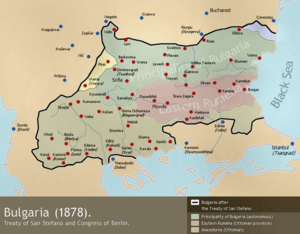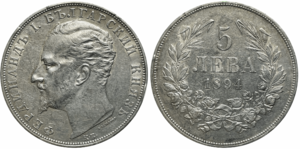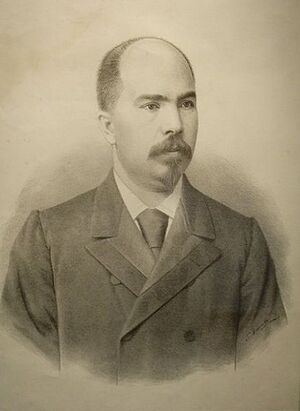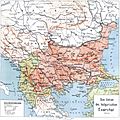Principality of Bulgaria facts for kids
Quick facts for kids
Principality of Bulgaria
Княжество България
Knyazhestvo Bălgariya |
|||||||||||
|---|---|---|---|---|---|---|---|---|---|---|---|
| 1878–1908 | |||||||||||

Principality of Bulgaria (dark green) and Eastern Rumelia (light green), united in 1885, formally as a personal union.
|
|||||||||||
| Status | vassal of the Ottoman Empire | ||||||||||
| Capital | Plovdiv (1878–1878) (Provisional Russian Administration in Bulgaria) Sofia (1878–1908) (Provisional Russian Administration in Bulgaria until June 1879) Tarnovo (1878–1878) (Bulgarian Constituent Assembly election, 1878) |
||||||||||
| Official languages | Bulgarian | ||||||||||
| Religion | Orthodox Christianity | ||||||||||
| Demonym(s) | Bulgarian | ||||||||||
| Government | Unitary absolute monarchy (1878–1878) Unitary parliamentary constitutional monarchy (from 1878) |
||||||||||
| Knyaz (Prince) | |||||||||||
|
• 1878–1886
|
Alexander I | ||||||||||
|
• 1887–1908
|
Ferdinand I | ||||||||||
| Regents | |||||||||||
|
• 1886–1887
|
Stefan Stambolov | ||||||||||
|
• 1886–1887
|
Sava Mutkurov | ||||||||||
|
• 1886–1887
|
Petko Karavelov | ||||||||||
| Chairman of the Council of Ministers | |||||||||||
|
• 1879 (first)
|
Todor Burmov | ||||||||||
|
• 1908 (last)
|
Aleksandar Malinov | ||||||||||
| Legislature | None (rule by decree) (1878–1878) National Assembly (from 1878) |
||||||||||
| History | |||||||||||
|
• Treaty of San Stefano
|
3 March 1878 | ||||||||||
| 13 July 1878 | |||||||||||
|
• Constitution
|
28 April 1878 | ||||||||||
|
• Unification
|
6 September 1885 | ||||||||||
|
• Independence
|
5 October 1908 | ||||||||||
| Currency | Bulgarian lev | ||||||||||
|
|||||||||||
| Today part of | Bulgaria Serbia |
||||||||||
The Principality of Bulgaria (Bulgarian: Княжество България, romanized: Knyazhestvo Balgariya) was a country that existed from 1878 to 1908. It was a vassal state, which means it was mostly independent but still officially under the control of the Ottoman Empire. This new state was created after a big meeting called the Treaty of Berlin in 1878.
Before this, the Russo-Turkish War ended with Russia winning. A first agreement, the Treaty of San Stefano, suggested a much larger Bulgaria. This proposed Bulgaria would have included many areas where ethnic Bulgarians lived, stretching from the Black Sea to the Aegean Sea. However, other powerful countries like the United Kingdom and Austria-Hungary worried that such a large Bulgaria would be too close to Russia. They feared it would upset the balance of power in Europe.
So, these powerful countries met at the Congress of Berlin. They signed the Treaty of Berlin, which changed the earlier plan. This new treaty created a smaller Principality of Bulgaria. It also set up an area called Eastern Rumelia as a separate, self-governing region within the Ottoman Empire.
Even though Bulgaria was officially an Ottoman vassal, it acted mostly like an independent country. It had its own constitution, flag, and national anthem. It also managed its own relationships with other countries. From 1880, it even had its own money. In 1885, Eastern Rumelia joined Bulgaria in a peaceful event known as the Bulgarian unification. The Ottoman Empire eventually accepted this. Finally, on October 5, 1908, Bulgaria officially declared its full independence and became the Kingdom of Bulgaria.
Contents
How Bulgaria Became a Country
From Ottoman Rule to Freedom
For a long time, starting in 1396, the Bulgarian Empire was part of the Ottoman Empire. During this period, the Bulgarian people lost their own leaders and their national spirit was suppressed.
However, in the late 1700s, a movement called the Bulgarian National Revival began. This movement helped Bulgarians remember their history and dream of having their own country again. Many uprisings against the Ottomans happened, similar to those in other parts of the Balkans. These events led to the Russo-Turkish War from 1877 to 1878.
The Treaty of Berlin (1878)

The Treaty of San Stefano, signed on March 3, 1878, suggested creating a large Bulgarian state. This state would have included regions like Moesia, Thrace, and Macedonia. Bulgarians still celebrate March 3 as their national day.
But other powerful countries worried about Russia's influence if such a large Bulgarian state was created. So, they decided to change the treaty. The Treaty of Berlin was signed in 1878. Important leaders like Otto von Bismarck from Germany and Benjamin Disraeli from the United Kingdom helped lead these discussions.
The new treaty created a much smaller, but still self-governing, Principality of Bulgaria. This new state was located between the Danube River and the Stara Planina mountains. Its capital became Sofia, though the old capital of Veliko Turnovo was also important. The Principality was still officially under Ottoman rule, but it was to be led by a prince chosen by Bulgarian leaders and approved by the European powers. They agreed the prince could not be Russian. As a compromise, Prince Alexander of Battenberg, a nephew of the Russian Tsar, was chosen.
South of the Stara Planina mountains, an area called Eastern Rumelia was created. This region was also self-governing but remained part of the Ottoman Empire. The region of Macedonia was given back completely to the Ottoman Sultan's control.
Bulgaria in the 1800s
Early Years and Unification
Bulgaria adopted a very modern and democratic constitution. Soon, the Liberal Party, led by Stefan Stambolov, became very powerful. Prince Alexander, the first ruler, was more conservative at first. But by 1885, he started to agree with Stambolov's liberal ideas.
Prince Alexander also supported the idea of uniting Bulgaria with Eastern Rumelia. This unification happened in September 1885 through a peaceful takeover in Plovdiv. Other European powers did not stop this because they were busy with their own problems.
Soon after, Serbia declared war on Bulgaria. Serbia hoped to take land while Bulgaria was busy with its unification. But the Bulgarians defeated Serbia at the Battle of Slivnitsa. They even pushed the Serbian army into Serbia. Bulgaria took back some towns like Pirot and Vranya that had many Bulgarian people. However, these towns were returned to Serbia with the Treaty of Bucharest in 1886.
Changes in Leadership
These events made Prince Alexander very popular in Bulgaria. But Russia was not happy with his liberal policies. In August 1886, Russia helped organize a coup that forced Alexander to give up his throne and go into exile.
However, Stambolov acted quickly. The people who led the coup had to leave the country. Stambolov tried to bring Alexander back, but Russia strongly opposed it. So, Alexander had to give up his throne again.
In July 1887, Bulgarians chose Ferdinand of Saxe-Coburg-Gotha as their new Prince. Ferdinand was supported by Austria-Hungary, and Russia refused to recognize him at first. Ferdinand worked with Stambolov for a while. But by 1894, their relationship became difficult. Stambolov resigned and was sadly killed in July 1895.
After Stambolov's death, Ferdinand decided to improve relations with Russia. This meant changing to a more conservative way of ruling. Towards the end of the 1800s, new tax rules caused unrest among farmers, especially in northeastern Bulgaria. These protests grew into open rebellions in 1900, but the government used the army to stop them.
Bulgaria in the 1900s
Towards Full Independence

Many Bulgarians still lived under Ottoman rule, especially in Macedonia. This was a complicated situation because Serbia and Greece also wanted parts of Macedonia. Serbia, being a Slavic nation, even thought Macedonians were part of the Serbian nation. This led to a struggle for control of these areas that lasted until World War I.
In 1903, there was a Bulgarian uprising in Ottoman Macedonia, and it seemed like war might break out. In 1908, Prince Ferdinand took advantage of the disagreements between the Great Powers. He used this chance to declare Bulgaria a fully independent kingdom. He became the Tsar (King) of Bulgaria on October 5, 1908. This day is celebrated on September 22 because Bulgaria used a different calendar until 1916. The declaration happened in the Holy Forty Martyrs Church, Veliko Tarnovo.
The Ilinden-Preobrazhenie Uprising

A major challenge for Bulgaria before World War I was the future of Macedonia and Eastern Thrace. In the late 1800s, a group called the Internal Macedonian-Adrianople Revolutionary Organization (IMARO) was formed. They started preparing for an armed uprising in the regions still controlled by the Ottoman Turks.
IMARO received support from the Principality of Bulgaria. They built a network of committees in Macedonia and Thrace. In August 1903, a large armed uprising, known as the Ilinden-Preobrazhenie Uprising, began in Macedonia and Thrace. Its goal was to free these regions. Or, at least, to make the Great Powers notice and push for better living conditions for the people there through new laws. After three months of intense fighting, the Ottoman army crushed the uprising. They used great force against the people living in those areas.
Princes of Bulgaria
| Picture | Name | Born | Died | From | Until | Notes |
|---|---|---|---|---|---|---|
 |
Alexander I | 5 April 1857 | 23 October 1893 | 29 April 1878 | 7 September 1886 | Gave up his throne |
 |
Ferdinand I | 26 February 1861 | 10 September 1948 | 29 April 1887 | 5 October 1908 | Became King of Bulgaria in 1908 |
Images for kids
See also










